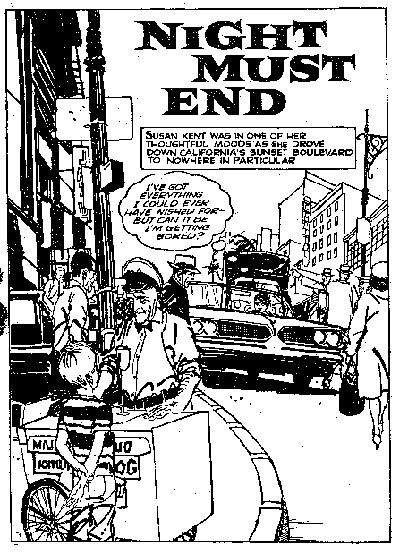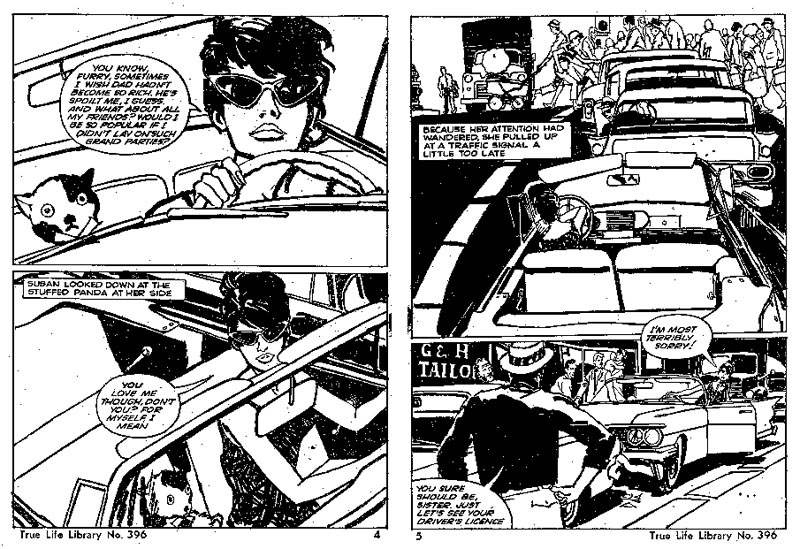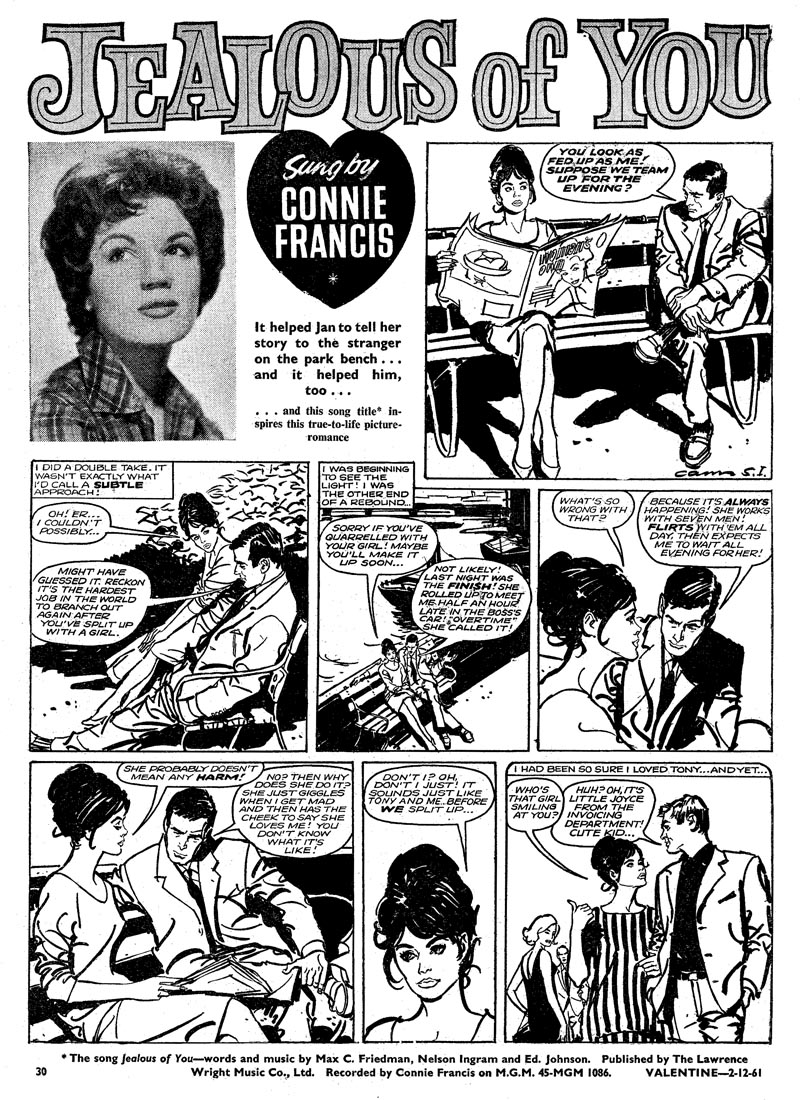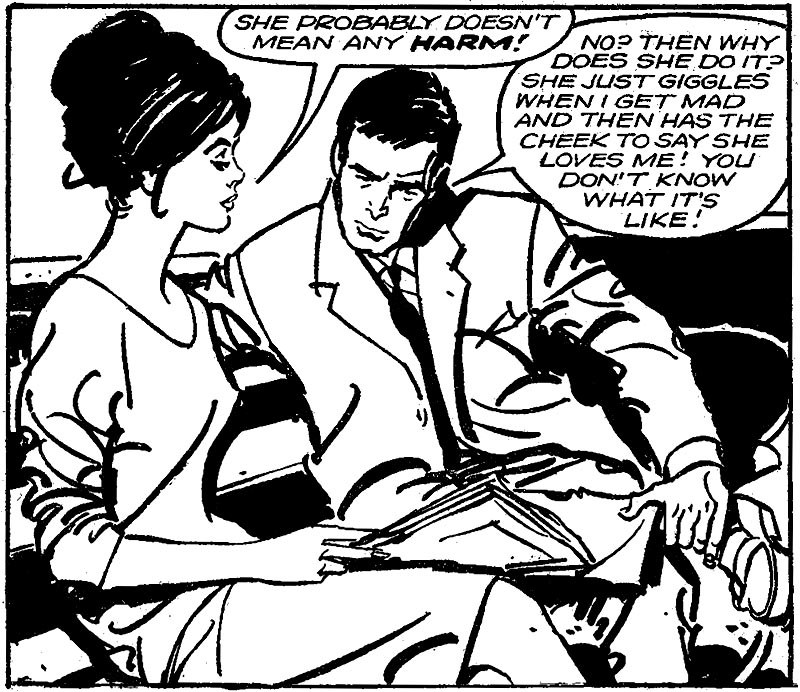I’m not an expert on Camps’ career prior to his British debut in 1960 but I would imagine it fits in with the majority of Spanish artists. Camps was born in 1929 which makes him a little bit older than most of the generation who worked for the U.K – a generation born after the Spanish Civil war growing up in a country that was both isolated and considerably poorer than the rest of Europe. Interestingly many of these artists were born and drew in Barcelona which must have the highest density of comic book artists anywhere in the world.

The biggest publisher in the country was Bruguera and like many others much of Camps’ earlist work appeared in their titles such as Pulgarcito and Aventuras De Capa Negra . Bruguera published far more than just comics though and camps also illustrated a series of classic childrens books including Robinson Crusoe, Heidi and Robin Hood. However, the company apparently paid quite badly so when the opportunity arose to work in Britain the artists jumped at the chance.

Differences in the exchange rate between Sterling and the Peseta meant that artists could earn as much as 3 times their usual Spanish page rate and though many came to loathe the unending succession of romance strips they had to draw most made a very good living out of them nonetheless.

When the Spanish artists hit Britain they were a revelation. Though many were very young , barely out of their teens in fact, they had an astonishingly assured grasp of anatomy and draughtsmanship coupled with a very modern sophistication in their rendering which made most of the British artists look decidedly old fashioned.

In the field of Romance the most influential artist was Jorge Longaron (later to find fame in the U.S. drawing the Friday Foster newspaper strip) whose pared back rendering and stunning girls looked thrillingly modern.

Inspired by Longaron his fellow artists in the S.I studio set the visual tone of British romance comics for over 20 years and Camps soon proved to be one the very best. Camps’ strip work is almost indistinguishable from Longarons’ and as you will see from the examples this week he mixed a thrillingly loose and expressive line with a sophisticated sense of composition – check out the use of negative space. His girls are absolutely typical of what I would call “the Spanish look” – heavy lidded, thickly mascara’d eyes, big hair, big lips, lithe, languid figures and a look that just screams the '60s.

Camps’ U.K strip work spanned the years 1961 to 1967 mostly appearing in the Fleetway titles Valentine, Roxy and Serenade.

The latter is particularly interesting because its’ covers featured a limited amount of colour which allowed the artists to be very bold and inventive and I think Camps work here is some of the very best in the genre.
Continued tomorrow.
actually,i'd love to see a whole book of these spanish artists romance work....fantastic!...
ReplyDeleteSome of these guys were really good.But there were also loads who who would repeat headshot after headshot over a 3 or 5 page story.
ReplyDeleteThe basic inability to tell a story, mixing camera angles etc, was a real weakness for a lot of these Spanish artists,who were being used to undercut the pay rates of British talent.
Somewhat like the influx of Phillipine Artists to the U.S comic scene in the 70s.Some good,a lot very average.And cheap.
David Roach replies:
ReplyDelete"I will concede that some of the artists did tend to repeat large headshots again and again ( though when they’re that beautiful I’m certainly not complaining) but the majority certainly didn’t. Artists like Camps, Longaron and Mas were being extraordinarily creative with composition and design- where deadlines allowed. Ever since the Spaniards first appeared in the U.S almost 40 years ago there has been this almost unthinking orthodoxy that they were all style and no content which I refute completely. Certainly, the artist who seemed to make the biggest impact – Esteban Maroto- did like to create very decorative, elaborate pages, but it was all done in the spirit of adventure and creativity, not because he couldn’t tell a story. Not that many people have ever seen them , but just prior to his Warren work Maroto drew a gorgeous romance serial set in the Napoleonic wars for the British romance comic Romeo which was extremely atmospheric and attractive and told resolutely conventionally. He – and they- could do the basics when they wanted to, but it was the 70s and they were all spreading their wings after the more conservative romance era."
"For those looking for great storytelling – check out Spanish masters such as Victor De La Fuente, Jose Ortiz, Luis Bermejo or Jesus Blasco all of whom absolutely had all the storytelling chops even the most hardened critics could ever hope for."
"Finally – let’s put to bed once and for all the myth that the Spaniards were hired as cheap labour. I can’t comment on the American side of things but I have seen the payment logs for several decades of British comics published by Britains’ biggest publisher Fleetway/IPC and I can assure you that they were paid exactly the same rates as the homegrown talent – not a penny less. I’d like to think you can see from the examples this week that Camps was hired for one reason only – that he was an incredible artist- and the editors knew it. The Spaniards weren’t anonymous serfs churning the strips out for disinterested editors – believe me, the editors knew exactly who was drawing for them , appreciated the artists for their individual talents and basically hired them for one reason only – they were good!"
Some were good.
ReplyDeleteI wouldnt seek to deny the talents of Fuentes,Bermejo and Blasco, but you only have to look through,for example, Girls Annuals of the late 60s and 70s, and you will see strip after anonymous strip rendered by these Spanish artists-all using very similar stylized headshots to tell an extended narrative.
Minimal backgrounds and very generic.
Ok,they may have been paid equally with UK artists, but in effect it was 3 times the amount factoring in the cheap cost of living in Spain. Given that comic art was not at all a well paid profession for artists in the UK, it was obviously a lot more attractive financially to the Spainiards.So, in effect, British artists WERE being undercut or replaced by this influx.
That isnt an "unthinking orthodoxy", that is the evidence of my own eyes and undeniable financial truth.For a country that has produced Bellamy, Embleton, Holdaway,Lawrence, Noble,Burns, Bishop,Colqhoun,Gibbons,Davis,Western,Hewlett, et al,do you really think there wasn't enough home-grown talent? Really?
I will say I enjoyed Mr Roach's books on War story cover art and was mightily impressed by the ability of Penalva and Gaspari.But all the time you had such an assymetric financial balance, a job worth say £1000 to a UK artist was worth £3000 to his rival!
Interesting, interesting, interesting. All of you folks, and certainly including Mr. Roach, are bending the brain of an old timer here! I suppose in the west we lived in a backwoods culture. We assumed we were pretty hip....and we observed closely what was coming from the east coast, Detroit, and the midwest. But don't know anyone here who paid attention to Spanish artists, cartoonists, illustrators, whatever. Why Spain? They have a formidable history of great art....but we had no knowledge of artists in mid century years. Thanks to all for the education!
ReplyDeleteInteresting that you bring up the name of Esteban Maroto, Leif, as my immediate reaction when I saw those comic pages you first posted was that they reminded me of the look of "Vampirella", and of course Esteban Maroto was one of the artists I recall most strongly from that great magazine. In fact, it seems to me that most if not all of those "Vampirella" illustrators had Spanish names, yet until this new topic of yours, I'd never known of the influence of these Spanish artists on the comic scene of the 60s. Thanks for the revelation!
ReplyDelete(PS: Totally unrelated, but the word I had to type in for word verification on this post was DAMONIZE. Should one contact an exorcist when Matt is nearby?)
lovely work!
ReplyDeleteThanks for sharing!
Charlie; Thanks for the comment - I'm delighted that you're discovering and enjoying Camps' remarkable talent along with me and so many others who were oblivious to his existence until David presented him to us!
ReplyDeletePete; I'm a big fan of the show "Supernatural" and according to their typical scenarios you should immediately pour a line of salt across all door and window sills. ;^)
ReplyDeleteTo clarify, I didn't mention Maroto - I was just forwarding our guest author, David Roach's remarks for the benefit of readers. But I'm with you - Maroto's work back in the 70's was jaw-droppingly good - and so different from his N American counterparts... so... exotic!
Chad; you're often contrarian perspective is always engaging and usually well-reasoned, but with respect, I wonder if you're not reaching on this one. David wrote that literally hundreds of artists were needed to supply all the artwork for over 100 titles per week! and that there were simply not enough native talents to fill the publisher needs. I'm not familiar with all the names you referenced but I recognized (Dave) Gibbons and (Jamie) Hewlett (and Guy Davis? - not sure about that one) ... anyway... David's talking about the situation in the '50s in England when, he says, "without much of a tradition of realistic strips to draw from talent proved to be thin on the ground".
ReplyDeleteWouldn't it be fair to say talent like Gibbons and Hewlett and no doubt many others were a result of both the long exposure to the work of the Spanish/Italian/S American artists, as well as the decades of Marvel/DC reprint titles?
Regarding the repeating large head shots issue: romance strips tend to be mostly about talking heads and I would think that was an issue among just about all romance artists, no matter their nationality. I seem to recall John Romita saying that was a main reason he was so anxious to abandon his romance comic assignments at DC in the '60s... he couldn't figure out how to not repeat himself again and again. From my own research I've discovered both Stan Drake and Leonard Starr - two of the most respected giants of romance comic strip art - often used stats to save time on their strips - no doubt you'd find a lot of those stats were repeated large head shot close-ups.
Finally, I'm not sure where you're going with the 3-to-1 payment issue. Are you saying that because the pay was (relatively speaking) so lucrative to the Spanish artists that they somehow colluded to keep the native British artists from landing those many romance assignments?
LP--
ReplyDeleteTerrific to see this stuff. I had very little knowledge of Camp's work, and it's volume alone is a revelation.
For me, my first long ago trip to Italy introduced me to the work of Ferdinand Tacconi, an Italian artist responsible for a big chunk of British war comics of the 60s and 70s.
Tacconi was far less well known in his own country. While he produced astonishingly authentic historical war material for the British market, with a wonderful grasp of ordnance and uniforms, he drew endless banal and silly erotic digest books for Italy.
It wasn't until the late 70s that he began to produce the sort of comics he was doing for the English language market in Italy, specifically for a well remembered series entitled UOMO D'AVENTURA.
His work remains an inspiration to me and my colleagues, and he figures in a character illuminating anecdote about Alex Toth.
Best,
HVC
woooow! great work, thanks for the post!
ReplyDeleteLeif,I used to go into newsagents in the late 60s and 70s and I can assure you I didn't see 100s of romance comics on the counters.You would see a mix of adventure comics for boys and girls' comics.Maybe like, 7 or 8 of each and then football based stuff and pop.Now a lot of these magazines would last a year or two and then be replaced by a new title to freshen interest.
ReplyDelete"without much of a tradition of realistic strips to draw from talent proved to be thin on the ground".
I didnt even mention Frank Hampson,Tony Weare,Keith Page, Gerry Embleton,Septimus Scott, Colin Andrew,Eric Bradbury,Mike White,Martin Aitchison,Eric Kincaid,Ian Kennedy,Frank Langford.I could go on, these were all regular,practicing strip artists in the UK.So there was no shortage of UK talent.
The point I'm making about the 3 to1 issue, Leif, is that these pay rates drew the very best foreign talents because for them it was unbelievable money.In the UK it was barely liveable.So there you've got Spanish artists competing with UK artists who would be comparatively much under-rewarded for their time.
If this were not the case why werent they working on Spanish comics.Answer; because by ,in effect,keeping a UK artist out of a job they were able to live like kings.
And I dont blame them for it.
Life IS competition,but this was not an even playing field.
Believe me,Camps looks a real talent,but even taking on board the financial issues, the bulk of this stuff was no way in the class of Stan Drake,Leonard Starr etc.
Check out a brilliant John Buscema romance strip called 'Oh My Lonely Nights' to see that a romance story neednt be a series of disembodied head shots.Corny but great.And of course the great Mr Toth contributed sterling -ahem- work.
I dont seek to be contrariwise, but as this is a forum of discussion I feel compelled to show the other side of the story.I also knew one of the previously mentioned artists, a stalwart of the British industry who gave me the heads up on how it was run.
Ruthlessly.
David Roach replies:
ReplyDelete"A quick reply to Chad’s reply!"
"Chad is sort of half right here – but is coming to the wrong conclusions. He is absolutely right that the difference in the value of the two currencies meant that the Spaniards did indeed do very well out of British comics. My friend Barry Coker ran one of the biggest art agencies in theU.K and on one visit to Spain he dropped in on Jesus Blasco and was met at the door by Blasco’s butler! I’m not sure even Alex Raymond had a butler. So yes, they certainly made money, but I don’t see how this is in any way undercut the British artists. I’ve drawn comics in Britain for over 20 years now and no-one has to convince me that the money isn’t great, believe me I know, but it was much more reasonable back in the 50s and 60s, the problem has been that the pay simply didn’t keep up with inflation. It was clearly commensurate with U.S rates for instance, since we had American artists like Alex Toth, John Severin and Werner Roth working over here for a time. No one became wealthy drawing comics but when Frank Hampson was drawing Dan Dare he was paid enough money to afford a whole studio of assistants – some to draw, others to ink or paint and even someone to make props and costumes."
"Chad might not believe me, but honestly, there were an enormous amount of romance ( and girls and War and Nursery et al) comics published over here , I could list them all but It would test the patience of our readers here. Just because he didn’t remember them doesn’t mean they didn’t exist. Might I suggest that as a boy he would not surprisingly more easily remember the comics published for boys? I think to emphasize the point just look at it this way – over 600 foreign artists worked in the U.K over a period of 25 years, that alone rather implies that there was a hell of a demand for talent. Another thing I’ll add is that it wasn’t at the expense of British talent either- if you were good enough there was work for you, the companies were desperate for artists irrespective of where they came from . I know for a fact that DC Thomson were initially unconvinced about “foreign labour” but they soon discovered that they couldn’t fill their comics solely with British artists so had to look elsewhere. And when the Spanish art came in it was frequently better than what the brits had to offer. DC Thomson comics of the 60s such as Jackie ( which was selling in vast numbers), Diana, Romeo, Cherie and Star Love were often exclusively Spanish in content, not because the artists were cheap but simply because they were better – particularly at this sort of material. By contrast I have a lot of comics from the 50s which were more commonly drawn by Brits and most were pretty sorry affairs, particularly the romances- if you ever get to see them you’d know why the companies would jump at the chance of using someone as attractive and inventive as Camps."
"Howard Chaykin makes an interesting point about Tacconi being better employed in the U.K than he would have been in Italy. From what I’ve seen the Spanish comics industry was even less inviting and there were far better venues for their work in Britain. But again, one unexpected consequence is that many of their best artists are completely unknown over there. Tacconi did find some recognition on his return to Italy – particularly for his work in colour magazines such as Corriere del Picolo , but for the Spanish this didn’t really happen. Instead you had the strange situation of Spanish artists getting recognition mostly through reprints of their American Warren and Skywald strips. Those that never made it across the Atlantic – like Camps and many, many others remain almost entirely unknown everywhere, including Spain. Until today I guess. "
Some great Longarón pages for UK here:
ReplyDeletehttp://deskartesmil.blogspot.com/2009/12/jordi-longaron-en-uk.html